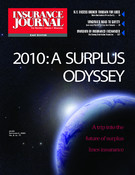When an employee crashes, so does the bottom line. In many cases, it is employers who bear the human, economic, and legal costs associated with a crash.
Consider the following scenario: Your employee is driving down the road talking on her cell phone to a client. Distracted by the conversation, your employee swerves and hits what she believes to be a deer. Your employee does not stop to investigate. Tragically, the deer was actually a 15-year-old girl. The girl was killed. Cell phone records and timesheets show that your employee was indeed on the phone at the time of the crash. Your employee is charged with a felony hit and run. And as her employer, you are named in a multimillion-dollar civil lawsuit.
This is exactly what happened to one law firm. And if you have employees on the road, it could happen to you. Over the past five years, there has been an explosion of litigation involving instances of distracted driving with settlements ranging from $500,000 to tens of millions of dollars. With the development and advancements of in-vehicle and mobile technologies, distracted driving cases similar to this one are expected to escalate.
When it comes to driver distraction, we’ve come a long way from just tuning the car radio. According to the National Highway Traffic Safety Administration, distracted driving behaviors are responsible for 20 to 30 percent of all traffic crashes. A recent study by the Insurance Institute for Highway Safety found that drivers using a handheld cell phone are four times more likely to be involved in crashes.
Furthermore, other studies indicate that not only do cell phones require drivers to remove one or both hands while driving; but they also significantly increase the driver’s mental workload. Research conducted by NHTSA and a host of others has suggested that hands-free does not mean crash-free. In one study, a team of researchers from NHTSA and the Virginia Tech Transportation Institute monitored 100 drivers over the course of one year and concluded that that the use of hands-free devices provide little safety benefit and offer a false sense of security.
While cell phones and other wireless devices attract most of the attention, they are not the sole cause of driver distraction. Driver distraction can and does take many forms. According to researchers at the University of North Carolina Highway Safety Research Center, objects, persons or events outside the vehicle, other occupants, moving objects in the vehicle, adjusting climate and radio controls, as well as eating and drinking are all common driver distractions linked to crashes. These instances are also a potential liability concern for employers. For example, a Baltimore trucking company agreed to a $1.25 million personal injury settlement, after one of its drivers, upon taking his eyes of the road to adjust his heater, crossed over a centerline and struck an on-coming vehicle, seriously injuring the driver.
The fact is driving is a complex task that requires drivers to look, listen, anticipate roadway hazards, and react safely. It requires a substantial degree of attention and concentration on the part of the driver. Drivers who are mentally or physically distracted react more slowly to traffic conditions and significantly reduce their “margin of safety” leading them to take risks that they may not otherwise take. It is estimated that a driver makes 200 decisions for every mile of driving. In some instances, even a momentary distraction can have devastating results.
If employers aren’t worried about what their employees are doing behind the wheel, they should be. More than 90 percent of all motor vehicle crashes are caused by human error. And with traffic crashes the leading cause of death and injury in the workforce, organizations with employees on the road are almost assured of having motor vehicle crashes.
Bottom line
When an employee crashes, so does the bottom line. In many cases, it is employers who bear the human, economic, and legal costs associated with a crash. The average on-the-job motor vehicle crash costs an employer $16,500. The more miles driven by employees, the higher the costs and legal liability for the employer. If employees are engaged in work-related activities behind the wheel, employers are potentially liable–regardless of who owns or provides the vehicle or whether the crash occurs during or after business hours. If an employee is found to be at fault for the crash, the damage to a company can be irreversible.
In an era where more employers are being held accountable for their employees’ roadway actions, it is imperative that employers understand their legal obligations to protect their company, its reputation and its employees. Whether employees drive for work or simply to and from work–it is critical to educate employees about traffic safety, promote safe driving practices, and implement and enforce safe driving policies.
Employers should implement a proactive training program that enables employees to identify potential distractions while driving and develop techniques and strategies to better manage and minimize these distractions.
Jennifer Duhoski is Marketing and Communications Manager for the Network of Employers for Traffic Safety. NETS, an employ-
er-led public/private partnership, is dedicated exclusively to traffic safety in the workplace. She may be contacted at jduhoski@trafficsafety.org or at (703) 891-6005.
Topics Auto Personal Auto
Was this article valuable?
Here are more articles you may enjoy.


 High-Net-Worth Risk Appetite Drops as Some Regions Show Stabilization
High-Net-Worth Risk Appetite Drops as Some Regions Show Stabilization  Kansas Man Sentenced to Probation for Insurance Fraud
Kansas Man Sentenced to Probation for Insurance Fraud  Disney Worker Injured Trying to Stop Runaway Boulder at Indiana Jones Show
Disney Worker Injured Trying to Stop Runaway Boulder at Indiana Jones Show  Howden Buys M&A Insurance Broker Atlantic Group in US Expansion
Howden Buys M&A Insurance Broker Atlantic Group in US Expansion 


